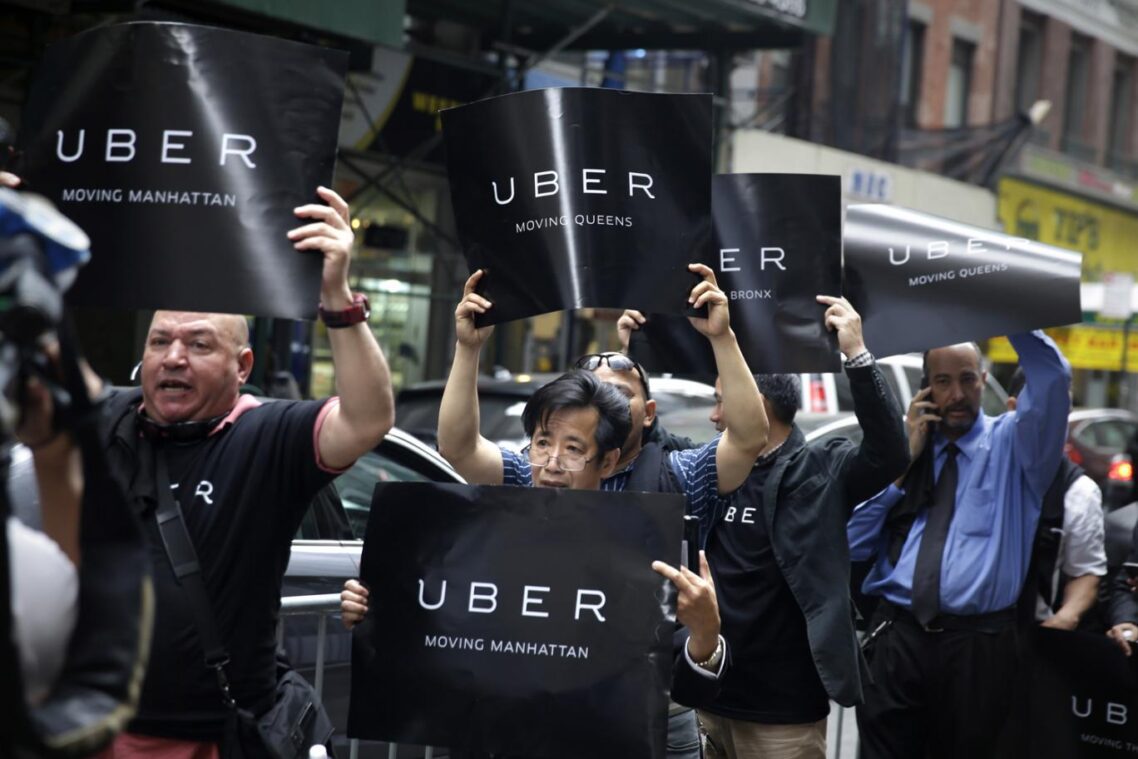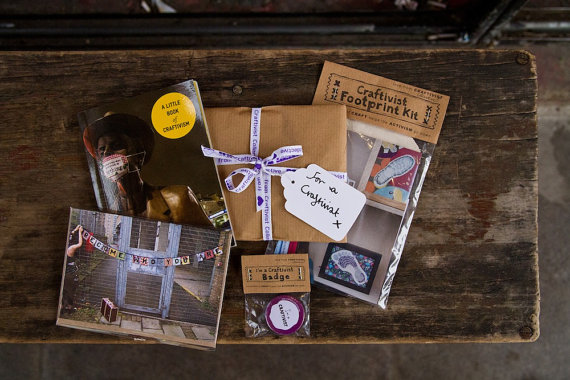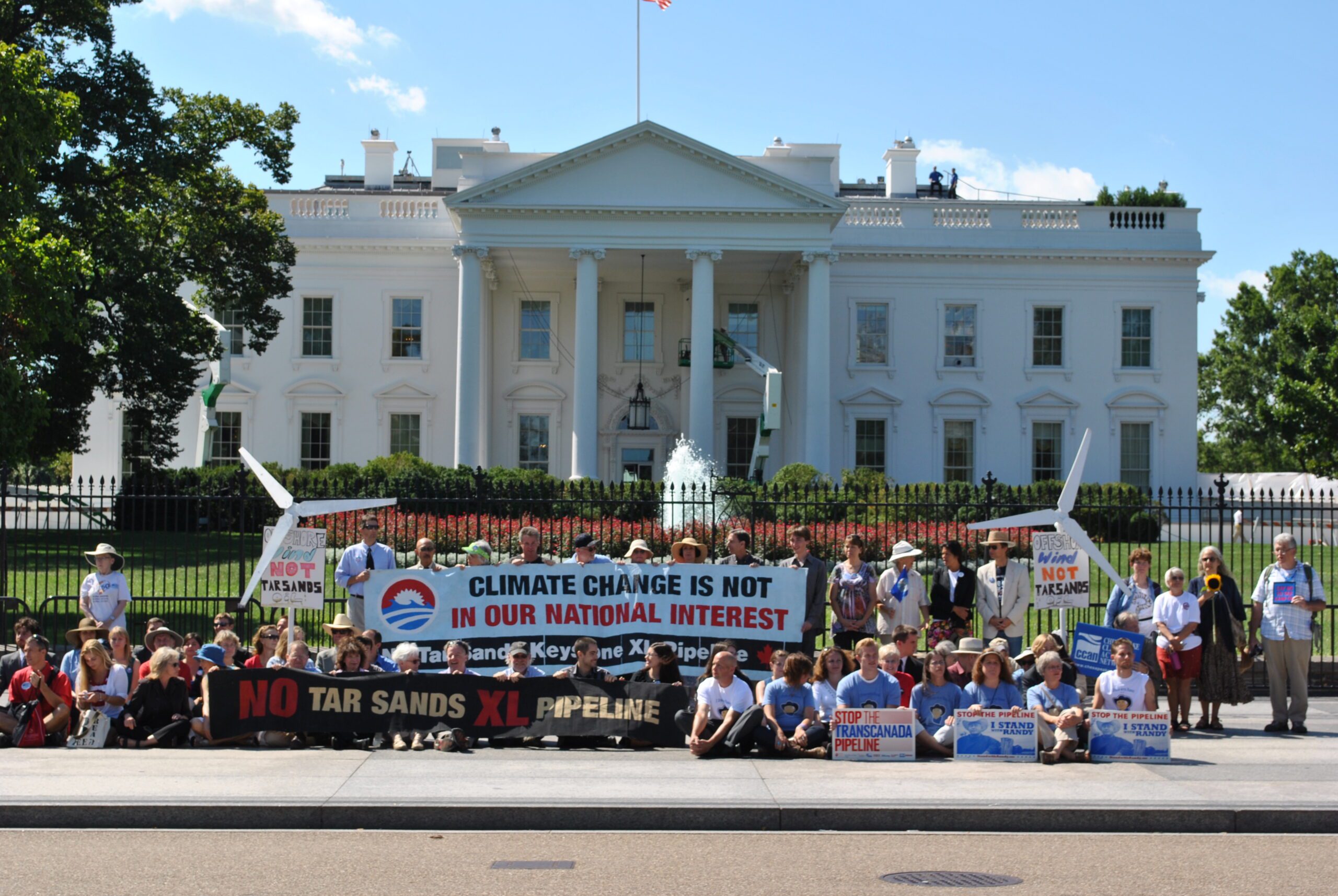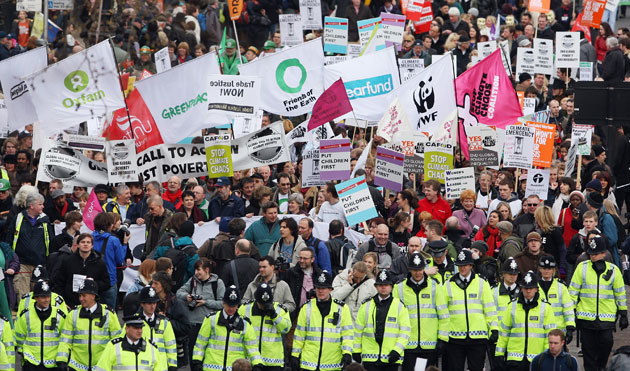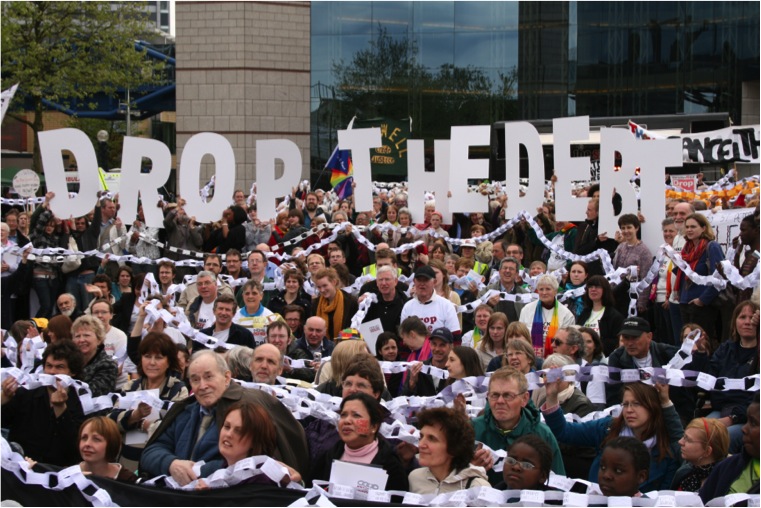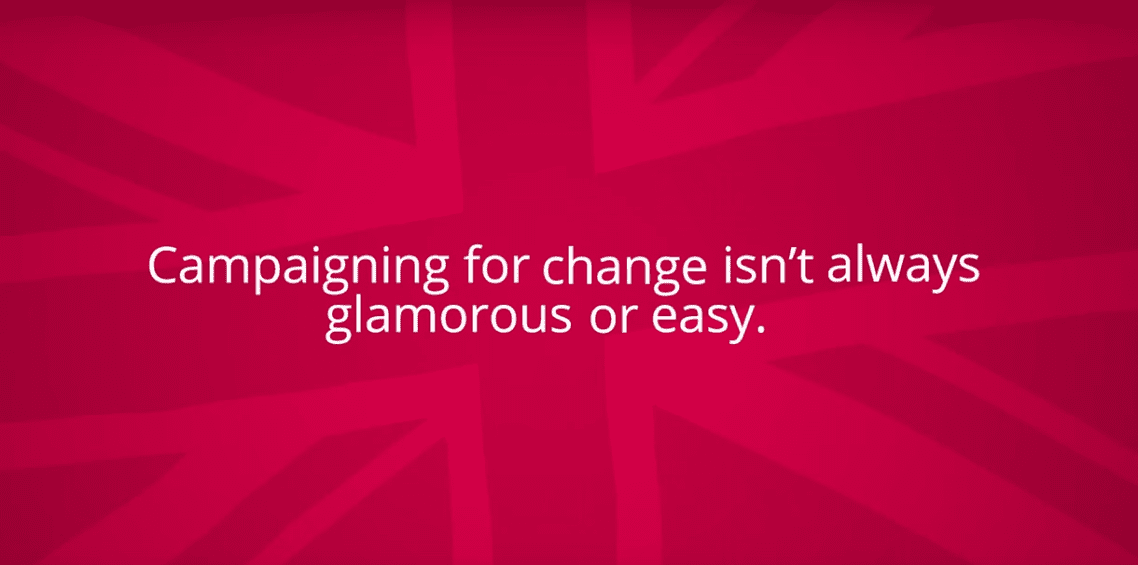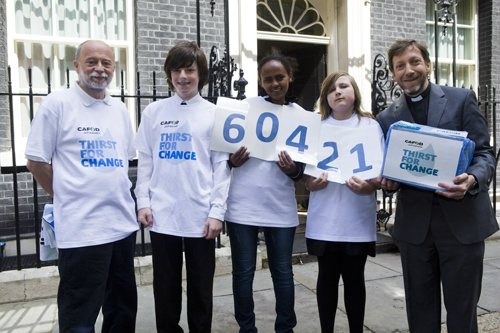It’s the big battle for London future. No, not the race for the Mayor of London, but between Uber and the Licensed Taxi Drivers Association (LTDA) as they’ve battled out for control of the taxi market in the city.
I don’t have a side that I favour in this particular battle (unlike the Mayor of London where I’m firmly on the red side).
I appreciate the investment that cab drivers put into learning The Knowledge, but get frustrated that in 2015 you still find cabs that only take cash. Living outside central London I’ve benefited from the flexibility of Uber, but the traditionalist in me doesn’t want to see the end of the iconic Black Cab.
But I think the approaches that the two sides have taken provide some insights into what direction campaigning might be going.
1 – Welcome to “App-tivism” – corporates campaigning isn’t new, of course its been a feature of newspapers to include a cut out petition for years, but the approach that Uber is taking shows a level of sophistication that we’ve not seen before. They don’t simply ask you to sign the petition, they’re employing some of the best campaign strategists to develop campaign approaches you’d expect to see Greenpeace or 38 Degrees invite you to take.
In New York they’ve been encouraging users to phone decision makers or take advantage of a “DE BLASIO” (after the New York Mayor) to the menu of ride options seen by its New York City users to see what impact his proposed restrictions might have, while I got the email below after an Uber journey I took last week.
As this Harvard Business School article suggests ‘we’re entering a brave new world where the creators of technology platforms can activate billions of users to specific political action of their choosing’. And its not just Uber, this collection shows how Airbnb and others are using the same approach, see more on Apptivists here.
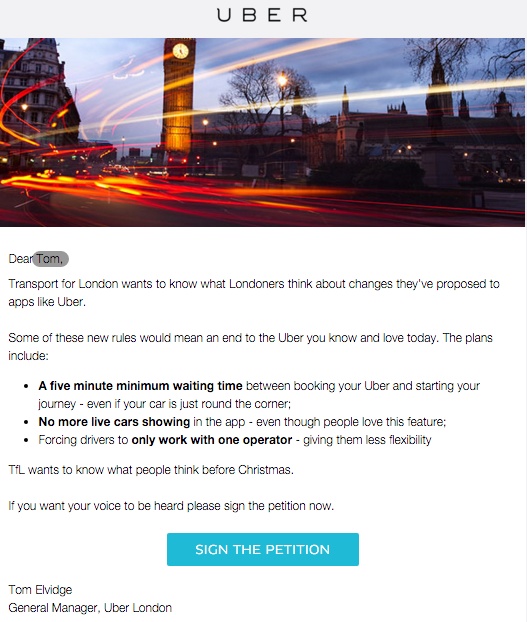
2 – Old power needs to adapt – But Uber doesn’t have it all their own way, the influence of the London cabbie as we head towards Mayoral elections next May, means that they’re powerful. Any aspiring candidate for Mayor of London doesn’t want to get on the wrong side of the cabbies, the seen as as trusted messengers by many.
I’ve really enjoyed what Jeremy Heimans has written about old and new power. LTDA are shown that old power can still influence, but how long will that hold? Does LTDA need to adapt and change its approach if it wants to continue to compete with Uber?
3 – Incentives to get you to take action – Unlike most campaigning organisations, Uber has a big advantage to get you to take action, it can provide you with incentives – free journey credit in return for sending an email for example (they’ll already offer to take you to a demonstration for free).
Uber’s strategy to dominate the taxi market is well known, so the cost of a few free journeys in return for the market access they want is a minimal cost. Alex Evan’s has reflected elsewhere about the concept of ‘activism air miles’, but if Uber and others start offering ‘free’ incentives in return for your action will it change the way that others have to respond?
4 – Use the Courts – Uber knows that building political pressure is just one tactic it needs to use to win what it wants, which is why its also devoting its resource to winning rulings in the High Court.
I’ve reflected before that using legal routes is under utilised in campaigning here in the UK, a few organisations like Client Earth have shown how it can effective can be, but the costs and complexity appear to rule it out for many. With the national political arithmetic unlikely to change in the next few years, exploring new routes like using the courts could be another option for campaigners.
Author: mrtombaker
Why Craftivism matters to me
Being the romantic that I am, to celebrate our first anniversary of dating I took my now wife, Demelza, to the 2003 Stop the War march in London.
We got about a quarter of the way around before it turned out that Demelza didn’t really like marches, so we headed into a bookshop on the route to watch the rest of the crowds go past.
It made me appreciate that not everyone is into marches, or the approaches to activism that are often the first that we encourage people to take in campaigning.
It’s one of the reasons I’ve come to appreciate the Craftivism (Craft + Activism = Craftivism) led by inspiring people like Sarah Corbett, despite not being a natural candidate to get out my needle and thread out.
It’s easy to scoff at craftivism. What difference does it make? Wouldn’t our resources be better focused on organising another march or stunt?
For me there 3 reasons why even the non-craft minded campaigner should be grateful that craftivism exists.
1 – Perhaps less is more? Craftivism presents an opportunity to do something different. This collaboration between Share Action and the Craftivist Collective targeting M&S shows that craftivism probably won’t lead to bulging postbags, but it can still have an impact on the ‘target’. Indeed this research suggests that for some decision the greater the volume of constituent contact they get the more they may devalue those grassroots lobbying efforts.
2 – Use the whole brain – Even for a campaigner who thinks that they’re the most uncreative, craftivism provides an opportunity for creative escape. It’s an opportunity to get creative, and reflect on how to solve problems using both right analytical and left creative sides of our brains.
3 – It’s good to slow down – As the Craftivist’s Manifesto says its all about slowing down and taking a ‘thoughtful approach to mindful activism’. In an environment where we spend so much time rushing from tactic to tactic, often fuelled by the excitement of social media we all need to find ways to practice mindfulness. Craftivism can help to provide that.
If you’re interested in learning more about Craftivism have a look at this training day that’s running on 10th December, and if you’re (already) stuck for ideas for Christmas, then Craftivism Collective’s shop is a good place to start.
6 campaign lessons from Obama's rejection of Keystone XL
Climate activists in the US secured a HUGE win last week, when President Obama rejected the building of the Keystone XL pipeline because of it’s impact on climate.
I’ve written before about the campaign and my admiration for 350.org, the organisations who have been behind so much of the campaigning. In the last few years, the pipeline has become a focal point for much climate activism in North America and beyond so the Presidents rejection last week is big win.
So what can other campaigns learn from this success? The first 3 lessons come from this brilliant video by 350.org co-founder and senior adviser Bill McKibben.
2 – Put your body on the line – right from the start of the campaign those involved have used peaceful, non-violent direct action at the heart of their approach. Together thousands of people have risked arrest, creating headlines and helped built a movement. The first period of direct action was deliberately timed when Congress wasn’t sitting to create a story, but since then they’ve kept the issue in the headlines by mobilising groups like the Sierra Club, celebrities, faith leaders, scientists and many others to get involved in non-violent direct action for the first time.
3 – Be creative – From circling the White House with a giant pipeline, to a Cowboy Indian Alliance protest on the National Mall, to the use of Obama’s campaign imagery in its graphics, the campaign has put creativity at the centre, providing lots of memorable images and moments.
I’d add a couple of others;
4 – Provided an abstract issue with a rallying point – Climate campaigning can be complicated with many of the policy solutions hard to mobilise around, but as David Roberts writes Keystone XL provided ‘clear villains, unambiguous markers of success, and local impacts that help draw support from other affected communities and demographics’.
5 – Drew on other movements – Those involved in Stop Keystone XL have a strong sense of where they fit within wider social justice struggles, as a result they’ve encouraged Keystone activists to get involved in Black Lives Matter protests, and invited those involved in the campaign to repeal ‘”don’t ask, don’t tell” in the US military to advise them.
But the final lesson goes to McKibben.
6 – Never Give Up – Remember when the campaign started, many climate activists in the US were bruised by the simultaneous failure to get domestic climate legislation passed (well documented here) and the collapse of the 2009 climate negotiations in Copenhagen, but the victory against odds is evidence that as Roberts writes ‘social change is nonlinear and devilishly hard to predict’ but yet ‘an important part of the most important fight in the world’.
To petition or not to petition
One of the fun parts of my job is that occasionally people come to me to ask for advice about the best campaigning tactic to use. (Let me know if I can bring my campaign advice clinic to you – I’m serious).
A few months ago, an organisation approached me asking if they should launch a petition for their latest campaign. Its a good question, in the days when petitions with 200,000 names in hours feels like a regular occurrence, where to start can appear daunting.
Here are a few thoughts that I shared.
1. It’s not simply about the numbers – Over the last few years we’ve been experience an petition arms race. Some groups are able to rapidly mobilise 100,000s of people to sign a petition. Looking at those numbers it can feel intimidating to start a petition, but when it comes to petitions, size doesn’t always matter.
Instead its about being clear about what your looking to demonstrate with the petition, a well targeted petition with a few thousand names can also be effective, or adopting a more creative approach which Scope have used brilliantly. Having said that, petitions that linger on a few thousand names probably aren’t the most effective way of influencing change.
2. Remember a petition is just a tactic – campaigning isn’t just about getting more names on a petition, its about change and other tactics are available. Identify and be clear what role your petition is going to have in delivering your change outcome. Saying, we’re doing it because we’ve always done it, isn’t an especially good reason.
Be clear are you looking for your petition to put the issue on the agenda by showing public support, or providing a target with a public mandate to do something (‘over 20,000 people have called on me to’) or demonstrate solidarity with those impacted by a policy change, or something else.
Remember opportunity cost, I’m yet to find a campaign that isn’t resource constrained. So if you decide to do a petition then you need to consider what tactic or tactics you can’t deploy as a result. Check you can’t achieve your outcome through other means.
3. Be clear on how long you want to run the petition for – I think you get two types of petitions at the moment, the ‘short-term and focused’ petition which is linked to a specific moment or policy change that your looking for (this is the bread and butter of platforms like change.org) and will be most effective if it can highlight a particular individual your looking to target, or the ‘long term and broad’ petition which can run over several months, which can have a wider policy ask, the One Campaign use these really well.
Both can have a role, the later can be repackaged to respond to different opportunities, while the former probably has a much tighter shelf life but can help to provide a opportunity for people to respond to something in the news.
4. If you do it, do it well – There is a not-so-secret source behind the formula that 38 Degrees, Avaaz and Change.org use. They show a clear link between the petition and the result your looking for.
So be specific and realistic in what your asking for, make the most of an crisistunity (that might mean holding back launching your petition until a moment when the media is interested in your issue), and have a compelling reader focused theory of change (if you do this, then we can do this, which means this will happen). The change.org model of ensuring a strong personal narrative from the petition starter is also a brilliant approach.
5. Make it easy to sign – remember not everyone is going to sign on to your petition from a desktop computer. Make sure your petition is mobile friendly, or go old school and have it available as a paper petition as well. Check that you’ve thought about the supporter journey after they’ve signed your petition. Can you use the signer to be a multiplier? When will you feedback to them about the impact it’s having? Can you invite them to take another action on your behalf? But please, and I’m a purest on this, don’t just run the petition to collect names for your next fundraising push.
6. It’s what you do with it that matters – Think about how you use the petition to leverage more profile for your campaign. The change.org approach ensure that the petition has at least 3 media moments, the launch, when it hits a significant number and then the handover. Make sure your plan a handover that will lead to a great photo which you can use in the media or with supporters, or use hitting a sigificant number to launch a policy briefing off the back of it.
How trustees can help campaigns thrive
Last week, I was working with some trustees involved in a charity that’s interested in investing more in mobilisation. It’s always fun to get out and about to help organisations looking to get stuck into campaigning.
Towards the end of the session, someone asked about the role a board can play in helping to support the organisations campaigning. I suggested the following;
1. Compliance – Trustees need to be aware of the regulations surrounding charity campaigning. They’re legally responsible for ensuring that charities meet it, so it’s good they know what can and can’t be done. But as I’m always keen to say, being compliant doesn’t mean a charity needs to be silent. The Charity Commission guidance on this clear says that campaigning can be done if it supports an organisation’s charitable activities. Trustees need to speak out when this right is being threatened.
2. Champion – If any organisation has decided to invest in campaigning and mobilisation it needs its trustees to champion this decision internally. Campaigning is about mobilising people to challenge systems and structures that hold power, and sometimes that will come into conflict with other work an organisation is doing (especially if they’re dependent on government funding where ). When hard decision need to be made trustees needs to trust their instincts that investing in campaigning will help their charity achieve its objectives.
3. Patience – Change through campaigning doesn’t always happen immediately, and as I’ve written about before, even when it does happen those impacts might not easily captured in a set of KPIs. Boards need to understand that it might be a few years before the full value of their investment is seen, and also work to ensure the metrics that a board uses doesn’t just look at outputs but also the stories behind the outputs.
4. Contacts – Trustees are often well connected individuals with contacts in media, government or other institutions that can be incredibly useful in helping to deliver campaign victory. Understanding how these can connections can be put to best use can be invaluable.
5. Challenge – It’s not the job of trustees to run the day-to-day operations of a charity, but that doesn’t mean that they shouldn’t taken an interest in the strategy that’s being developed. The best campaign strategies have assumptions tested and challenged to ensure they’re as sharp as they can be, and trustees can often help bring another perspective to the plans. Trustees should also appreciate that good campaigning requires flexibility to respond to changing circumstances.
Campaigners can also support trustees. The composition of board often lags a few years behind the latest thinking in charities, which mean many charity boards still don’t have people with campaign experience on them. Encouraging people that do to join boards would help.
Speed, Sophistication, Structures and Space – 4 trends that will define the future of campaigning
In my role as Head of Campaigns and Engagement at Bond, I was ask to write about the trends that will impact the campaigning of members over the next 5 years, and what it means for our work to support members to campaign brilliantly. I came up with the following;
1 – Speed
The first campaign I was involved in was Jubilee 2000. I remember the record breaking petition, the sense of excitement as the latest Christian Aid News would come through the letterbox with an update, and the delighted when we heard we had succeeded in getting the G8 to cancel the unpayable debt.
It took the Jubilee 2000 campaign over 2 years to collect the 22 million signatures that formed the record breaking petition handed to G8 leaders. Anyone who collected those signatures will talk of the hours spent collecting petitions in churches, at street stalls and in student unions bars across the UK, winning the signatures one conversation at a time.
Fast forward to today, where it’s possible for a partnership between Guardian and Change.org to generate 250,000 signatures on FGM in 20 days, and many Bond members are able to generate tens of thousands of emails in a matter of days or weeks. Campaigning organisations able to launch a campaign in a matter of moments in respond to the latest event or news headline.
But while campaigning is getting faster, we’re also seeing a rise in slow activism? Organisations like the One Campaign and Tearfund are encouraging supporters to write handwritten letters to MPs around the recent legislation on 0.7% or All We Can encouraging supporters to stitch mini-protest banners ahead of London Fashion Week, part of creative ‘craftavist’ movement, which encourages reflective action that seeks to change the participant as much as it does the world. I think we need both within our movement, and a willingness to learn from both approaches.
2 – Sophistication
We know more about our supporters than we ever have, what actions the like to take, what topics they’re interested in, if and when they’ll open their emails from us, and as a result we can target our campaigns in more and more sophisticated ways. A recent report suggested “neuro-campaigning” following politics and advertising to use a better understanding of how our own brains work to persuade people to take action. With all this evidence, as campaigners we need to continue to invest more and more in testing of our messages and tactics before we share them.
A focus on what tactics to use, shouldn’t mean we overlook the importance of theories of change at the heart of our campaigning, including challenge ourselves to ask if we’re too focused on targeting our campaigning towards MPs, Government Ministers and UN bodies, or if we should follow Action Aid focusing on local councillors, or corporate divestment championed by Share Action and 350.org, or local media like RESULTS.
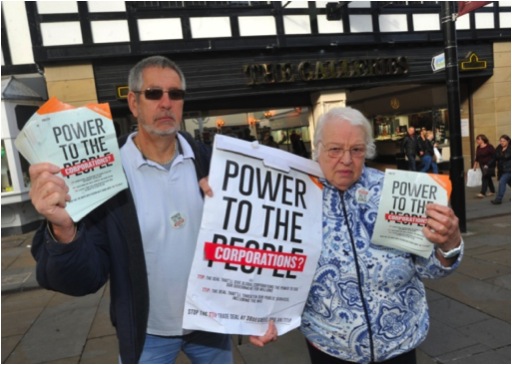
3 – Structures
As much as we need to build campaigning structures that are fit for a digital era, we shouldn’t overlook the importance of investing in an active and vibrant grassroots network. For me it’s always been the hallmark of our movement, the local activists that collect names on petitions and meet with their MPs.
I want to learn from groups like 38 Degrees, about how they mobilised 10,000+ volunteers as part of the Days of Action on TTIP, or Toys will be Toys, an entirely volunteer led campaign about how they’re successfully joining up offline and online actions.
A focus on structures should not only be about how campaigns are organised, but also about challenging the very structures that perpetuate inequality and poverty. While we should take advantage of opportunities like the recent Private Members Bill on 0.7%, but the danger in focusing on ‘the little big thing’ is that we risk not building public understanding about the root causes of poverty that should be central to our campaigning.
4 – Space
The Lobbying Act or comments by the former Charities Minister that we should ‘stick to knitting’ reinforce to me that we’re seeing a narrowing of the political space campaigning organisations have to advocate. I believe we should feel proud as a sector of the positive impact our campaigning has had on the lives of the communities we work with. We should all fight to protect it.
Before starting at Bond, I helped to found Campaign Bootcamp, a training programme for those looking to start a career in campaigning. We were overwhelmed by the generosity and enthusiasm we found to help us. That experience has shown me the strength of the community we have, committed to work together to share and help each other.
This is an edited version of an article first published in The Networker available here.
So you've joined the Labour Party – now what?
In the last few weeks many of those I work and campaign alongside have joined the Labour Party. So for readers who aren’t members of the Labour Party (or interested in party politics), please forgive me as I go ‘off topic’.
For those who have joined. Welcome.
I’m glad to be on the same team as you. I hope these notes will be of use, because I was like you just 7 years ago and have had the most amazing time being involved over the last few years. Like you want to see a Labour Government in 2020 because I believe we achieve more in power in one day than we do in a 100 days in opposition.
1 – Remember we are one party – You won’t agree with everything that everybody says all the time, and not everyone voted for Jeremy Corbyn (I didn’t but that doesn’t meant we can’t be friends!). But 99% of people I’ve met within the Party are members for the right reasons (and many of them are still exhausted from an General Election campaign followed by the Leadership election). Like you they have a passion for social justice and a fairer world. More unites us than divides us. So look for the good in everyone you meet.
2 – Get involved now – Don’t leave it until 2019. The media are looking for a story about how Labour is unelectable and the 2016 elections in London, Scotland and in councils across the country will be the first time they get to write that story. It’s easy to join interest groups within the Labour Party, known as Socialist Societies. They can be great ways to meet people who share your interest, but please get involved in your local Constituency Labour Party (CLP) as well.
Bring your skills, energy and experience as a campaigner and get stuck in. I can’t promise that it’ll always be easy, but CLPs are the basic organising unit for Labour and they need people like you in them. It’ll also help you get to know your community, its only through my involvement in Tooting Labour that I’ve had the pleasure to make friends from across my community.
3 – Knock on some doors – Firstly it’ll make you a better campaigner, but it’s also the most effective way we have as a party of getting out . The person who’s taught me the most in the Labour Party has a phrase that is so true ‘friends do things for friends’ and talking to people all year round is a way of doing this.
Sure we need to change the way we run our canvassing, engage in more of a conversations, find ways of empowering local people to take action so we’re doing it with people rather than for them, but disappearing from our communities won’t help people think that the Labour Party is a ‘friend’.
4 – Find the people who inspire you – Some of the people you’re going to meet in your local party aren’t going to be the people you’ll want to bound down to the pub with, but at meetings and events you’re bound to spot people who interest (and perhaps even inspire) you.
Get to know them, as my guess is that they’re the type of person who’ll want to change things, but perhaps because they’re now a Councillor or a CLP Officer they don’t have the time or energy to do that (I remember bounding into my local party in 2010 full of ideas but if I’m honest by 2015 I’d run out of some of that energy to get things done as the pressures of life and helping keeping my local party going got to me). Get to know them, ask them how you can help to change the culture of your CLP, make plans, share ideas, work together. These people want to pass the baton onto you.
5 – Stand for office – Within the next 12 months each CLP will hold elections for its officers – the volunteers who make things happen. Consider standing for office to bring your skills and ideas to help run your local party. If you want to really change things this can be a great place to do it, and if you are successful get to know others in the same position in other constituencies to share ideas.
6 – Change the ways meetings happen – There are some cliches about parts of Labour Party meetings which are fair, but you can help to change the way meetings are held.
Suggest changes to the venue to make it more welcoming, think about the set up – do you have to sit in rows, change the agenda – we used to have the speaker/policy discussion first followed by the business later – it’s amazing how many people don’t complain about the minutes of the last meeting when they want to get home at 9.30pm! Ensure that you find ways for more people, find speakers who’ll be interesting, helping to facilitate discussions in small groups, etc, etc.
Every time you walk away from a meeting because you found it dull those who are happy with the status quo win! Don’t just complain, go with suggestions to change things.
7 – Help outside of London – Historically local parties in London and a few other large cities have been much bigger than in many other areas of the country, so if you’re interested in helping the party win in 2016, go on a road trip to help the party in those marginal seats in the Midlands, Kent, and beyond we need to win in 2020 to form a government.
8 – Believe we can win everywhere – I grew up in Surrey Heath, its an area unlikely to elect a Labour MP anytime soon, but there is a ward that does have 2 Labour Councillors. If you’re in a safe Conservative seat ask around to understand if there are similar wards we used to be active in, and if there are think about getting involved. In the 1990s, the party ran a brilliant programme called ‘Operation Toehold’ which helped the party to start winning in seats that they eventually took in 1997. We need the same now, to show that Labour can win up and down the country.
9 – Get to know your organiser – As my local MP never tires of reminding our meetings, we’re a volunteer party, we don’t have lots of paid campaigners, and most Councillors and Officer do this alongside the ‘day job’, but many CLPs do employee an organiser. They’re often brilliant young campaigners, who are asked to work miracles week-in, week-out for little pay. Get to know your organiser, offer to share your campaigning advice, encourage them, and ask how you can help.
10 – Always have some loose change in your pocket – You’ll soon find that the Labour Party loves a good raffle. It’s because most local parties don’t have huge reserves, so every opportunity to raise a few pounds will help to fund the next newsletter or the organisers salary.
PS – Get in touch if I can help offer any advice. Together we’ll win again.
How campaigners can help ensure crisis equals opportunity..
It’s an appropriate question given the headlines on the current refugee crisis, and the opportunities for advocacy and influence that it appears to be providing for many groups who’ve toiled on these critical issues for years.
So how do we, as campaigners prepare for those crisis, that cause a set of fundamental assumptions or rules to be challenge in such dramatic way.
It’s all to easy to see crisis as something to be avoided, but as this excellent article on the missed opportunities for progressives from the 2008 financial crisis suggests ‘crisis equals opportunity, for those who are ready to use it’.
1. Take time to prepare – We can’t anticipate every crisis, but how much time do we spend preparing what we might do.? Look around at those who’s job it is to respond to unexpected crisis, from the security forces, who play our scenarios often on a grand scale, to the staff in the humanitarian response departments of many large NGOs. They role play. It means in the unlikely event of those situations happening they know how to react most effectively.
Can campaigners learn a thing from this? One of the things I enjoy most about Campaign Bootcamp that I helped to set up is the way we use a scenario to bring the campaigning that we’re teaching too life. I’m struck by how little we actual play out how we’d respond to different scenarios. How many team away days are dedicated to exploring what we’d do if.
2. Have a set of asks on the shelf – The father of free market economics, Milton Freedman is often quoted ‘When that crisis occurs, the actions that are taken depend on the ideas that are lying around. That, I believe, is our basic function: to develop alternatives to existing policies, to keep them alive and available until the politically impossible becomes the politically inevitable’ so campaigners for change’.
Do we have the same for the issues that we’re campaigning on? It doesn’t need to be long document, but something that could be dusted down. It might be seen as an indulgence, but I’m struck how the 2008 financial crisis came and many of those working on economic issue didn’t have a set of responses ready to go. There were opportunities to push for significant change but we didn’t have those asks to hand..
3. Look for the signs – Predicting crisis isn’t easy but taking time to learn the skills of those who effectively predict what might happen is a useful skill to add to a campaigners toolkit. What is that they were looking out for that helped, what was the evidence that they saw that led them to a different conclusion to the mainstream?
In the Pathways to Change: 10 Theories to Inform Advocacy and Policy Change Efforts, the authors talk about the ‘Large Leaps’ theory of change, suggesting that change can happen in sudden, large bursts that represent a significant departure from the past. The theory holds that conditions for large-scale change are ripe when the following occur:
As campaigners are we looking out for those signs?
4. Hold your nerve, but don’t cry wolf – There’s a risk that anyone who focuses on looking for a crisis can cry wolf. Spotting what they perceive to be a crisis, but isn’t actually one. Do this too often and your credibility can take a hit. The skill for any campaigner is to hold steady, seeking the evidence that the crisis is real and calling out the opportunities. One of the things that we’re going to be discussing with Tearfund colleagues is the difference between the opportunities presented by the climate and financial crisis. Perhaps the different here is the climate crises feels like its a long-term challenge, while the financial crisis was a much more sudden shock that we didn’t anticipate.
5. Present a positive vision – Crisis are unsettling, things we thought in the past were true are no longer, and at that moment its easy for campaigners to revert to the ‘told you so’ high ground, but as George Lakey suggests “when crisis comes, who is ready with what vision?”. In this article he argues that the both Occupy and 1968 French Student protest failed in part because they didn’t have positive vision that gripped the mainstream. He suggests that ‘in addition to campaigning, I would add another building block: Try empowering the visionaries you know to do homework. We’ll need their vision work — in concert with wide discussion — for the next crisis’.
How To – Handover a petition to Downing Street
In hope it’s helpful to others. Here are my top tips;
- The security for Downing Street is overseen by Charing Cross Police Station so you’ll need to give them a call about booking a slot. Make sure you give as much notice as you can. I’m not clear on how many slots there are per day, but there are some times when you shouldn’t expect a slot, when Cabinet is meeting for example.
- You’ll need to fill in a form which provides the details of everyone who’ll be going up to those famous doors. Your allowed to take 6 people and unless your photographer is a member of the NUJ (National Union of Journalists) they count as part of the 6.
- On the day you’ll need everyone coming to bring along appropriate ID. MPs and members of the media who are members of the NUJ don’t count as part of the total.
- You can’t take in props or fancy dress and you’ll probably be limited to a box of petitions (about the size that a ream of paper comes in). The best hand-ins that I’ve seen normally have someone holding a sign which explains the campaign and the number of actions plus a well branded box. Organisational T-Shirts are fine. If you Google Image Search ‘Downing Street Petition’ you’ll get a good idea what’s possible.
- When you arrive, go the security gate on the left of Downing Street, expect to go through airport style security (so perhaps have someone waiting outside with bags and other belongings) and then your given an appropriate amount of time to walk up the Street and to the Door.
- Don’t expect to be able to linger too long- you’ll get 30 minutes maximum. Most of the time the street is quiet but if your lucky you might find a few journalists and camera crews waiting in the pen across the street you seen them talking from on the news.
- As with any good campaign, plan what photos and footage you want to get before you go in. Think about how you want your photo to look like. If you want to get any short pieces to camera for filming expect to do that by the media pen you see on TV.
- The Prime Minister doesn’t come out to collect your petition, but you do get the opportunity to knock on the door and handover the box of petitions to the police officer.
- Remember the front door to No 10 is the door to an office, so staff will be coming in and out while you’re on the street. They could be important so make a good impression!
- I’d always make sure that at the top of your box is a letter which has your campaign asks in it and the number on people who’ve taken action. You probably want to get your public affairs colleagues to email a copy of that to your relevant Number 10 contact – don’t suppose they’ll hear about it because you were outside the building!
- If you’ve got loads of boxes of petitions then the rest need to be taken to a Post Office near Victoria Station – exact details are on the form you’ll fill in. I’ve no idea what happens with them after that, although sadly I don’t think they end up at Number 10.
- Your going to get loads of footage and images from your handover. They’re great for feeding back to supporters who took action and on social media.
These are my notes based on my experiences over the years. Things change so please do share any updates you have in the comments below and always check with the relevant authorities before you start planning.
Here's "cow" you do it. Learning from #MilkPrice campaign
There British brethren haven’t been as visible, but over the last few weeks the success of dairy farmers in getting supermarkets to increase the price the pay for milk has been a summer campaign success, and from what I can tell all without the need for an email petition.
It’s been an interesting campaign to follow and I’ve been struck by a few lessons for all campaigners from it.
1 – Pick the right target – the farmers haven’t focused on all supermarkets but a handful (Morrissons and Asda) that aren’t paying a fair price. It’s a smart approach focusing on brands that are in a very competitive market and don’t want to be seen to lose the favour of customers. By playing the supermarkets off against each other they’ve created a virtuous cycle where no retailer wants to be caught out. Interesting now they’ve won the first round, all the supermarkets have agreed to pay more, the asks and target of the campaign aren’t nearly as clear but they’ve got the momentum of a quick win.
2. Think about the values behind your messages – listen to any of the protesting farmer and, yes there are messages about the importance of preserving our rural way of life and protecting our national food security, but it’s also about fairness and hard working farmers being bullied by the profit driven supermarkets. They’re powerful messages that will resonate with many whatever their political persuasion. It’s a smart communications strategy.
3. Produce a great image – Who can’t fail to find both the images of farmers buying up all the milk in a store with the #milktrolleychallenge or even better taking a cow into a supermarket an intriguing and powerful image. Firstly through social media and then through broadcast media it’s a great image to fill the media in the traditionally quiet ‘silly season’.
4. Find authentic spokespeople – I’ve actually no idea if any specific organisation is behind the campaign (I’m assuming it’s the NFU or similar) but that’s in part because everyone I’ve heard interviewed for the campaign is a farmer, so the message is direct from the (ahem) horses mouth. What the campaign has lost in professional polish it’s gained from an authentic and directly affected voice.
